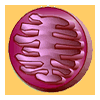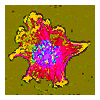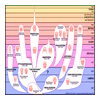 |
||||||||||
Updated: August 9, 2024
Epigenetics
Genes Sleeping on the Job
New Therapies Based on a Better Understanding of Cell Biology
 An interesting new clinical trial has opened up for CLL patients,
one that may have potential for low toxicity as well as good
efficacy. As a refreshing change from the usual heavy doses of
chemotherapy, this trial is based on using very low doses of
drugs, often as little as ten times lower than the amounts used
under standard regimens. The rationale for this approach is
equally interesting. The DNA in a cell's nucleus is a vast
library of information which normally defines and regulates
how the cell functions. In cancer cells, however, the information
retrieval mechanism is often at fault. The idea here is to use
just enough drugs to correct this fault, and thereby allow the
cancer cell to kill itself. Click here to read
Epigenetics.
An interesting new clinical trial has opened up for CLL patients,
one that may have potential for low toxicity as well as good
efficacy. As a refreshing change from the usual heavy doses of
chemotherapy, this trial is based on using very low doses of
drugs, often as little as ten times lower than the amounts used
under standard regimens. The rationale for this approach is
equally interesting. The DNA in a cell's nucleus is a vast
library of information which normally defines and regulates
how the cell functions. In cancer cells, however, the information
retrieval mechanism is often at fault. The idea here is to use
just enough drugs to correct this fault, and thereby allow the
cancer cell to kill itself. Click here to read
Epigenetics.
Target Mitochondrion
Promising New Approaches Bypass the Usual Cellular Control Points and May Level the Playing Field for Bucket C Patients
New Research on Attacking Mitochondria in B-CLL Cells
 Several recent research articles have opened up exciting new opportunities in the treatment of CLL. These feature new small molecule drugs that take an entirely different approach to targeting CLL cells. In this new approach to treating CLL, it seems to make no difference if you are IgVH mutated or unmutated, CD38 positive or not, chemo-naïve or have been through the wars with every chemotherapy drug known to man. In fact, there are some indications that heavily pretreated and late Rai stage patients may respond better to this approach. To learn more about these exciting new drugs on the horizon, read Target Mitochondrion.
Several recent research articles have opened up exciting new opportunities in the treatment of CLL. These feature new small molecule drugs that take an entirely different approach to targeting CLL cells. In this new approach to treating CLL, it seems to make no difference if you are IgVH mutated or unmutated, CD38 positive or not, chemo-naïve or have been through the wars with every chemotherapy drug known to man. In fact, there are some indications that heavily pretreated and late Rai stage patients may respond better to this approach. To learn more about these exciting new drugs on the horizon, read Target Mitochondrion.
Adhesion, Homing and Resistance
Why Peripheral Blood Numbers Do Not Tell the Whole Story – and Why CLL Cells Are Hard to Kill
It's a Tale of Adhesion Factors, Chemokine Trails, Receptors and Blockers
 The behavior of CLL as a disease and the different characteristics exhibited by
strains with different clonal genetic aberrations are all related to cellular chemistry.
We examine a number of critical aspects such as resistance to therapies, bulkiness of
lymph nodes, infiltration of bone marrow and the support structure for CLL cells in
their preferred environments. We also look at some futuristic possibilities for
therapies in this article,
Adhesion, Homing and Resistance to Therapy.
The behavior of CLL as a disease and the different characteristics exhibited by
strains with different clonal genetic aberrations are all related to cellular chemistry.
We examine a number of critical aspects such as resistance to therapies, bulkiness of
lymph nodes, infiltration of bone marrow and the support structure for CLL cells in
their preferred environments. We also look at some futuristic possibilities for
therapies in this article,
Adhesion, Homing and Resistance to Therapy.
Cytogenetics of ATM and TP53 Genes
Gatekeepers of our Health
These Genes Are Critical to the Natural History of CLL
 The TP53 gene and the ATM gene play a critical role in the behavior of CLL cells.
We explore the roles of these genes in the life of a normal cell and their malfunction
in cancer. Modern FISH analysis focusing on these genes helps identify the risk
characteristics and aggressiveness of a given patient's CLL and therefore is an important
prognostic tool. Click here to read
Cytogenetics of ATM and TP53.
The TP53 gene and the ATM gene play a critical role in the behavior of CLL cells.
We explore the roles of these genes in the life of a normal cell and their malfunction
in cancer. Modern FISH analysis focusing on these genes helps identify the risk
characteristics and aggressiveness of a given patient's CLL and therefore is an important
prognostic tool. Click here to read
Cytogenetics of ATM and TP53.
Clonal Evolution
Acquired Resistance to Therapy by Selection
The Nature of CLL: How the Disease Grows and Evolves
 In this article we review important new research into the mechanisms by which clonal
B-CLL cells become more aggressive and harder to kill. This is Darwinian selection
at the cellular level. We look at the implications for treatment strategy and offer
a new approach to managing the disease in
Clonal Evolution.
In this article we review important new research into the mechanisms by which clonal
B-CLL cells become more aggressive and harder to kill. This is Darwinian selection
at the cellular level. We look at the implications for treatment strategy and offer
a new approach to managing the disease in
Clonal Evolution.
p53: The Anti-Tumor Gene Located on Chromosome 17p
The Tumor Suppressor Gene and its Associated Protein
The Worst Cytogenetic Mutation in CLL
 Deletion of the gene at chromosomal location 17p13.1 is really bad news in CLL — and most other cancers.
This article discusses the function of the gene and describes how its associated protein works to repair
DNA damage — or, if the damage is too great, to trigger cellular suicide. Read about it in
The p53 Gene
Deletion of the gene at chromosomal location 17p13.1 is really bad news in CLL — and most other cancers.
This article discusses the function of the gene and describes how its associated protein works to repair
DNA damage — or, if the damage is too great, to trigger cellular suicide. Read about it in
The p53 Gene
Genetics
Genetic Mutations and Their Effect on Overall Survival
Important Paper Identifies Common Genetic Abnormalities
 The difference between good prognosis and poor prognosis for a CLL patient resides at least in part on
the particular genetic abnormality that characterizes the patient's disease. Stilgenbauer, Dohner, et al.,
lay out some basic correlative data on common mutations and survival expectations associated with them.
Therapy choices should be made based on the risk associated with each type of abnormality. To learn more, read our review of their paper, Genetic Abnormalities in Blood Cancers.
The difference between good prognosis and poor prognosis for a CLL patient resides at least in part on
the particular genetic abnormality that characterizes the patient's disease. Stilgenbauer, Dohner, et al.,
lay out some basic correlative data on common mutations and survival expectations associated with them.
Therapy choices should be made based on the risk associated with each type of abnormality. To learn more, read our review of their paper, Genetic Abnormalities in Blood Cancers.
 Enter Keywords: |
———
Disclaimer: The content of this website is intended for information only and is NOT meant to be medical advice. Please be sure to consult and follow the advice of your doctors on all medical matters.
Copyright Notice:
Copyright © 2024-2007 CLL Topics, Inc. All Rights Reserved.
All materials contained on this site are protected by United States copyright law and may not be reproduced, distributed, transmitted, displayed, published or broadcast without the prior written permission of CLL Topics, Inc. You may not alter or remove any trademark, copyright or other notice from copies of the content.
However, you may download and print material from CLLTopics.org exclusively for your personal, noncommercial use.
———
